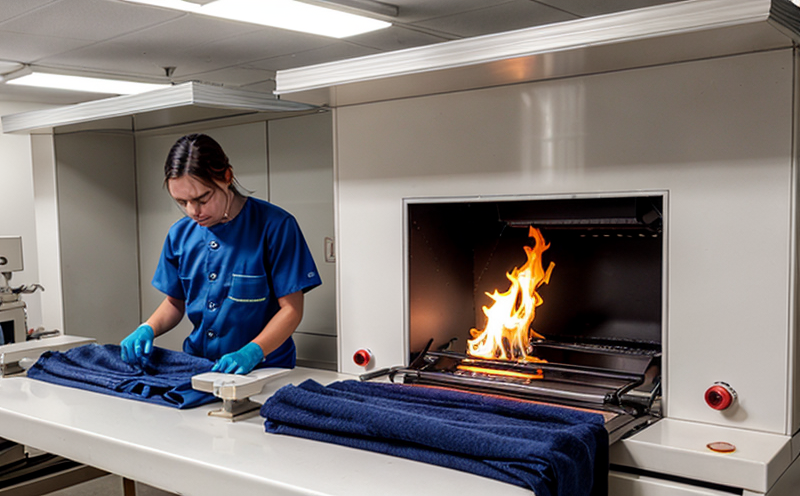Thermal Protective Performance Testing of Firefighter Clothing
The thermal protective performance (TPP) testing of firefighter clothing is a critical component in ensuring the safety and well-being of firefighters. This testing evaluates how effectively the clothing resists heat, flame, and other sources of thermal energy that may be encountered during firefighting operations.
Firefighters are exposed to extreme conditions where their protective gear must provide reliable protection against flames and high temperatures. The performance of this gear is paramount in preventing injuries or fatalities. TPP testing ensures that the clothing meets the necessary standards, which have been established by various organizations such as the National Fire Protection Association (NFPA) and other international bodies.
The testing process involves subjecting a sample of firefighter clothing to controlled thermal conditions. The sample is exposed to a heat source for a specified duration. After exposure, the temperature difference between the outside surface of the fabric and the inside surface where the wearer would be positioned is measured. This temperature difference indicates how well the fabric insulates against heat transfer.
The test results are used to determine the thermal protective performance value (TPPV), which quantifies the time in seconds that the fabric can protect the wearer from reaching a critical temperature. A higher TPPV score signifies better protection, indicating that the fabric has a greater ability to insulate against heat and prevent heat transfer to the skin.
Understanding the implications of the test results is essential for quality managers, compliance officers, R&D engineers, and procurement personnel involved in developing or selecting firefighter clothing. These professionals must ensure that the materials used meet stringent safety standards and are capable of withstanding real-world firefighting conditions.
- Test samples are typically cut from actual garments to simulate real-use scenarios.
- The heat source is standardized, ensuring consistent testing across different materials and manufacturers.
The importance of TPP testing cannot be overstated. It directly impacts the safety of firefighters who rely on this equipment for their lives. By adhering to strict standards and undergoing rigorous testing procedures, we can ensure that the clothing provides reliable protection under demanding conditions.
Why It Matters
The thermal protective performance of firefighter clothing is crucial because it directly affects the safety of firefighters in high-risk environments. The ability to withstand and insulate against heat is critical for preventing severe burns and other injuries that can occur during firefighting operations.
Firefighters frequently encounter situations where they are exposed to intense heat, flames, and other thermal hazards. Their clothing must provide a barrier between the wearer and these dangers, ensuring that the skin remains protected from excessive heat transfer. The performance of this protective layer is measured through TPP testing, which provides a quantitative value indicating how effective the fabric is in insulating against heat.
Compliance with relevant standards such as NFPA 1971 ensures that firefighters have access to equipment that meets the highest safety and performance criteria. This compliance not only protects individual firefighters but also contributes to overall public safety by ensuring that emergency responders are adequately prepared for any situation they may encounter.
The results of TPP testing provide critical data for quality managers, compliance officers, R&D engineers, and procurement personnel involved in the development and selection of firefighting gear. These professionals use these test results to make informed decisions about material choices, design modifications, and sourcing strategies that enhance both performance and safety.
By prioritizing thermal protective performance testing, we can ensure that firefighters have the best possible protection when they respond to emergencies. This commitment to safety not only improves individual firefighter welfare but also strengthens community resilience by ensuring that first responders are equipped with reliable gear.
Applied Standards
The thermal protective performance testing of firefighter clothing is guided by several international standards and codes, including NFPA 1971. This standard establishes the requirements for the design, construction, and performance of structural firefighting garments to ensure they provide adequate protection in various fireground conditions.
Other relevant standards include ISO 20342 and EN 469, which outline specific protocols and acceptance criteria for TPP testing. These standards provide clear guidelines on the test procedures, equipment calibration, specimen preparation, and data analysis necessary to achieve accurate and consistent results.
The testing process typically involves exposing a sample of firefighter clothing to controlled thermal conditions using a standard heat source. The sample is then measured for temperature differences between its outer surface and the inner lining where the wearer would be positioned. This measurement helps determine the TPP value, which reflects the time in seconds that the fabric can protect against reaching critical temperatures.
Compliance with these standards ensures that firefighters are equipped with gear that meets rigorous safety requirements. This compliance not only protects individual firefighters but also contributes to overall public safety by ensuring that emergency responders are adequately prepared for any situation they may encounter.
Environmental and Sustainability Contributions
- Eco-Friendly Materials: The use of sustainable materials in firefighter clothing can significantly reduce the environmental impact. Recycled fibers, organic cotton, and other eco-friendly textiles are increasingly being incorporated into fire-resistant garments.
- Recycling Programs: Many manufacturers now offer recycling programs for used firefighting gear, ensuring that non-recyclable components are properly disposed of in an environmentally responsible manner.
The integration of sustainable practices into the design and production of firefighter clothing not only enhances environmental stewardship but also supports broader sustainability goals within the fire safety sector. By choosing materials and processes that minimize waste and reduce carbon footprints, manufacturers can contribute positively to global efforts to combat climate change.





